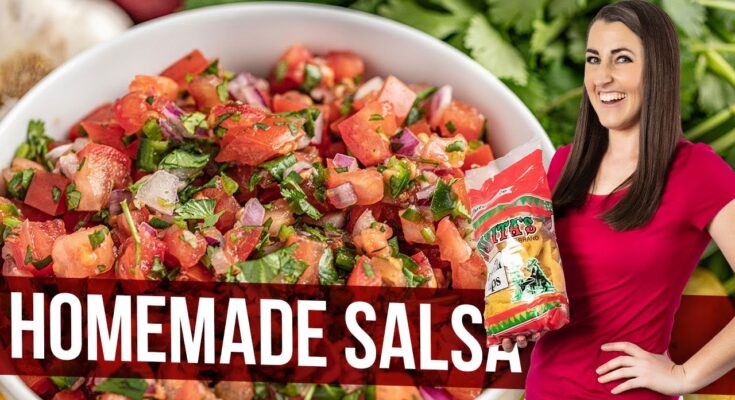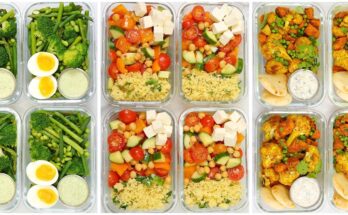Salsa Recipe: Who doesn’t love a flavorful salsa? It’s one of those universal condiments that can instantly elevate your meals, from simple chips to tacos, burritos, and even grilled meats. Whether you prefer it chunky or smooth, mild or spicy, salsa can be customized to fit your taste perfectly.
What Makes Salsa Special?
Salsa stands out because of its versatility and vibrant flavors. The base ingredients—fresh tomatoes, onions, and chili peppers—offer a fresh, zesty kick that’s both refreshing and satisfying. Plus, salsa works equally well as a dip, topping, or marinade, making it a staple in many households.
Common Types of Salsa
- Salsa Roja: The classic red salsa made with tomatoes and peppers.
- Salsa Verde: Made from tomatillos, giving it a tangy flavor.
- Pico de Gallo: A chunky, uncooked salsa made with raw ingredients.
- Fruit-based Salsas: Mango or pineapple salsa offers a sweet twist.
Ingredients You’ll Need
Fresh Produce Essentials
- Tomatoes (4-5 medium, ripe)
- Onions (1 small, white or red)
- Jalapeño or Serrano Pepper (1-2, depending on spice level)
- Garlic (2 cloves)
- Cilantro (A handful for freshness)
- Lime (1 for acidity)
Spices and Seasonings
- Salt (to taste)
- Ground Cumin (1/4 teaspoon)
Optional Ingredients for Customization
- Avocado (for a creamy texture)
- Corn or Black Beans (for a hearty salsa)
- Hot Sauce (for added heat)
Kitchen Tools Required
Blenders vs. Food Processors
While a blender works well for smooth salsas, a food processor gives more control over texture. If you like your salsa chunky, a food processor might be the better option.
Alternative Tools if You Don’t Have a Blender
No blender? No problem! You can finely chop all the ingredients by hand to make a rustic salsa with a chunkier texture.
Step-by-Step Salsa Recipe
Step 1: Gather and Prepare Ingredients
Wash all your vegetables thoroughly to remove dirt and pesticides. Cut the tomatoes, onions, and peppers into quarters to make blending easier.
Step 2: Roast or Grill Vegetables (Optional)
Roasting your tomatoes, peppers, and garlic adds a smoky flavor to your salsa. Place them under the broiler for 5-7 minutes until they develop charred spots.
Step 3: Chop the Ingredients (Manual or Blender)
If you’re making chunky salsa, dice the tomatoes, onions, and peppers into small pieces. For smoother salsa, throw everything into a blender or food processor.
Step 4: Blend to Desired Consistency
Pulse the ingredients for a chunky texture or blend continuously for a smoother salsa. Make sure not to over-blend unless you prefer a liquid-like consistency.
Step 5: Season the Salsa
Add salt, cumin, and freshly squeezed lime juice. You can also throw in a pinch of sugar if the tomatoes are too acidic.
Step 6: Taste and Adjust
Taste your salsa and adjust the seasoning. Need more heat? Add more chili. Too bland? A bit more salt or lime will help.
Storing Your Salsa Properly
Refrigeration Tips
Transfer your salsa to an airtight container and refrigerate it. The flavors will continue to develop, so it’s often even better the next day.
How Long Does Salsa Stay Fresh?
Fresh salsa typically lasts 3-5 days in the fridge. If it starts to smell sour or look slimy, it’s time to toss it.
Serving Ideas and Pairings
Perfect Dishes to Serve with Salsa
- Tortilla chips
- Tacos and burritos
- Grilled chicken or steak
- Scrambled eggs or omelets
Drinks That Complement Salsa
Pair your salsa with margaritas, beer, or a refreshing glass of lemonade for a perfect snack or meal.
Salsa Variations to Try
Pico de Gallo
A raw, chunky salsa with diced tomatoes, onions, cilantro, and lime juice.
Salsa Verde
Made with roasted tomatillos and green chilies, giving it a bright, tangy flavor.
Mango or Pineapple Salsa
A fruity twist on salsa that pairs beautifully with grilled fish or shrimp.
Common Mistakes to Avoid
Over-blending Your Salsa
If you blend your salsa for too long, you might end up with a watery texture. Pulse the ingredients for better control.
Forgetting to Taste and Adjust
Salsa is all about balance, so always taste and tweak as you go. A small pinch of salt or an extra squeeze of lime can make a big difference.
FAQs about Salsa Recipe
1. What ingredients are used in a basic salsa recipe?
A classic salsa recipe includes fresh tomatoes, onions, garlic, cilantro, lime juice, salt, and chili peppers. You can also add variations like mango, avocado, or corn for a twist.
2. How do I make salsa spicier?
For a spicier salsa, add more jalapeños or substitute with serrano or habanero peppers. Adjust gradually to match your heat tolerance.
3. Can I make salsa in advance?
Yes! Salsa tastes better after resting for a few hours as the flavors meld. Store it in the refrigerator for up to 5 days in an airtight container.
4. What are the best tomatoes to use for salsa?
Roma tomatoes are a popular choice due to their firm texture and low water content, but any ripe, flavorful tomato will work.
5. Can I freeze homemade salsa?
Yes, you can freeze salsa, but it may lose some of its texture. To minimize this, drain excess liquid after thawing before serving.
6. How can I thicken salsa if it’s too watery?
If your salsa turns out watery, you can thicken it by adding tomato paste or draining excess liquid through a fine-mesh strainer.
7. What dishes pair well with salsa?
Salsa complements many dishes like tacos, grilled meats, quesadillas, chips, and even scrambled eggs. It’s a versatile condiment!
Conclusion
There you have it—a simple, step-by-step guide to making salsa at home! Whether you prefer it smooth or chunky, mild or spicy, you can tweak the recipe to suit your personal taste. With just a few fresh ingredients and minimal effort, you’ll have a delicious salsa that will impress at any gathering. So, go ahead and give it a try—you won’t be disappointed!
References
Below are reputable sources for further reading and validation of the information provided in this Salsa Recipe with Post Links. These references ensure the content’s accuracy and offer additional tips and variations for your salsa-making experience:
- AllRecipes – Explore various salsa recipes and expert tips: AllRecipes Salsa Guide.
- Food Network – Learn from professional chefs on salsa preparation: Food Network Salsa Recipes.
- Bon Appétit – Find creative twists on traditional salsa: Bon Appétit Salsa Ideas.
- Serious Eats – Detailed explanations of salsa ingredients and methods: Serious Eats Salsa Techniques.
- BBC Good Food – Check international salsa variations: BBC Good Food Salsa Guide.
These sources provide deeper insights into salsa preparation, ensuring your dish is both authentic and flavorful.



